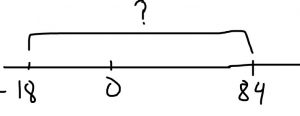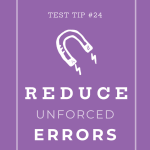
I am working with a student who is shooting for the 96th percentile on the ACT. She’s got a good shot at it. She missed 12 questions on a recent ACT math section which put her in the 91st percentile. She needs to answer about 6 more questions correctly to reach that score.
The good news is that she knows the math. The bad news is that she’s making a lot of “silly” mistakes – a lot of unforced errors.
Forced errors
Of course there are going to be questions on the ACT and SAT that you don’t know how to answer. She had no idea how to approach matrices, finding the side of a similar triangle, or a log question.
She can try to learn new math (or remember old math), but there’s an easier way to increase her score.
You can try to learn new math (or remember old math), but there's an easier way to increase your score: reduce your unforced errors.Reduce your unforced errors
For a lot of my students, the reason they’re not scoring where they want to has nothing to do with their math (or english or science) knowledge. It has everything to do with their meticulousness.
There’s no sense in losing points you would have otherwise gotten right. This is what separates a good score from a great score. (And, by the way, it’s why I score way above my pay grade on the math section of the ACT and SAT. I simply don’t miss questions I know how to answer.)
S. got sloppy. She flipped a triangle and accidentally switched the two angles. On another question she solved for x instead of x+4. On another she used the formula for area of a circle instead of circumference of a circle.
All of which is understandable when you’re under pressure and moving quickly to answer all the questions. But she simply can’t lose points on questions that she’s capable of answering and reach her target score.
So how do you fix this common problem? Wishing it would go away doesn’t work. Neither does “trying harder.”
Here are three tactics that practically prevent unforced errors from happening in the first place.
1. Re-read the question
AFTER you solve the question, but BEFORE you look at the answer choices, go back and RE-READ the last part of the question to make sure you know what they are looking for. So solve for x, then go back and re-read the problem and realize that they want x+4.
(Most of my students never give me wrong answers to a problem. They give me correct answers to what they *thought* the problem said. But the SAT and ACT only give points if you answer *their* question correctly, not your own.)
(This is one of the secret strategies for the ACT and SAT – my students routinely net a 50 point increase just from using this one tactic.)
2. Draw a picture
Yesterday another top student missed a simple question. If the lowest temperate was -18 and the hottest temperate was 84, what was the range? She calculated 84-18 instead of 84-(-18).
If she had sketched a quick picture instead,

it would have made it easier to see that she would have to add 18 to 84 to get the correct answer.
3. Slow down
You can’t turn into a turtle, but every kid can benefit from slowing down and working much more methodically. (I’ve had to tell exactly one student over the past 500 students to speed up.) I tell my students to quickly work slowly through the problems.
You will get a higher score by focusing on fewer problems and getting them correct than by rushing through and trying to answer every question. (And when you guess, guess strategically.)
3 tactics that practically prevent unforced errors from happening in the first place: 1. Re-read the question. 2. Draw a picture. 3. Slow down.

